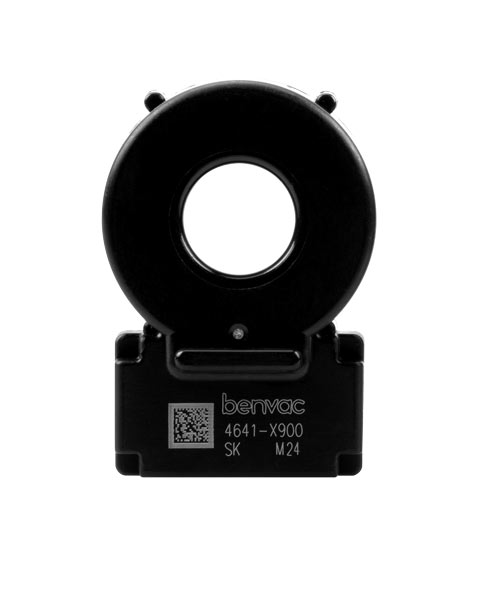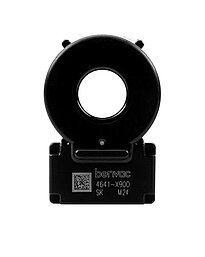benvac® RCMB121
To satisfy new standards including IEC 62752 and IEC 60364-7-722, the charging of electrical vehicles requires residual current sensors to avoid hazardous situations in cases where the vehicle battery (DC) is connected to the home power supply (AC). Generally, AC/DC sensitive residual current sensors can be used where direct current and alternating current circuits are directly connected and therefore AC/DC leakage currents can occur.
Typically type A residual current circuit breakers (RCCBs) are installed in private households. However, these RCCBs are to identify and deactivate DC fault currents. In order to charge an electric vehicle (EV) from a home power supply, a costly type B RCCB would be required to guarantee safety in the event of a DC fault current. By using the benvac DI sensor in an IC-CPD or a wall box, the requirements for electrical safety and all-current fault detection can be fulfilled by the patented measuring method and this at a significantly reduced cost than comparable type B RCCB.
A single DI sensor simultaneously monitors all currents in phases and neutral conductors sensing AC/DC fault currents. The sensors can activate automatic shut-off in the event of hazardous electrical faults. As the residual currents to be monitored only occur in the event of electrical faults and are extremely low (mA), maximum measurement precision is critical. In addition, a fast response time is required to maintain safety features.

To satisfy new standards including IEC 62752 and IEC 60364-7-722, the charging of electrical vehicles requires residual current sensors to avoid hazardous situations in cases where the vehicle battery (DC) is connected to the home power supply (AC). Generally, AC/DC sensitive residual current sensors can be used where direct current and alternating current circuits are directly connected and therefore AC/DC leakage currents can occur.
Typically type A residual current circuit breakers (RCCBs) are installed in private households. However, these RCCBs are to identify and deactivate DC fault currents. In order to charge an electric vehicle (EV) from a home power supply, a costly type B RCCB would be required to guarantee safety in the event of a DC fault current. By using the benvac DI sensor in an IC-CPD or a wall box, the requirements for electrical safety and all-current fault detection can be fulfilled by the patented measuring method and this at a significantly reduced cost than comparable type B RCCB.
A single DI sensor simultaneously monitors all currents in phases and neutral conductors sensing AC/DC fault currents. The sensors can activate automatic shut-off in the event of hazardous electrical faults. As the residual currents to be monitored only occur in the event of electrical faults and are extremely low (mA), maximum measurement precision is critical. In addition, a fast response time is required to maintain safety features.
Features
- Protects against hazardous situations with fault currents, preserving RCCB type A from saturation
- Small volume and footprint for integration into compact IC-CPD
- Robust mechanical and electrical design suitable for harsh environmental conditions
- Electrical safety at low cost (compared to RCCB type B)
- Integrated self-monitoring and test functions
- Compliant with standard IEC 62752 and UL 2231
- Patented measurement technology (Patents: EP 2 571 128 / US 9,397,494 / ZL 201210157968.6 / CN 103001175, EP 2 813 856)
Applications
Charging mode 2
- IC-CPD in charging cables for electric vehicles (EV) and plug-in hybrid electric vehicles (PHEV)
Charging mode 3
- Wallboxes for charging EV and PHEV
- Charging piles for charging EV and PHEV
benvac® RCMB121 Variant(s)
| Version | Type VAC | Type Bender | Art. No. |
|---|---|---|---|
| 6 mA DC/30 mA r.m.s | T60404-N4641-X900 | RCMB121-1 | B94042490 |
| 5 mA r.m.s./20 mA r.m.s | r.m.s. T60404-N4641-X901 | RCMB121-2 | B94042491 |
Downloads for benvac® RCMB121
| Name | Category | Size | Language | Timestamp | D-/B-Number |
|---|---|---|---|---|---|
| Residual current sensors | Flyer | 344.7 KB | 2024/10/2929.10.2024 | ||
| We are your eMobility partner! | Flyer | 262.3 KB | 2023/11/2929.11.2023 | ||
| RCMB121-1 | Datasheets | 786.9 KB | EN | 2021/10/2020.10.2021 | |
| RCMB121-2 | Datasheets | 1.0 MB | EN | 2021/10/2020.10.2021 |

